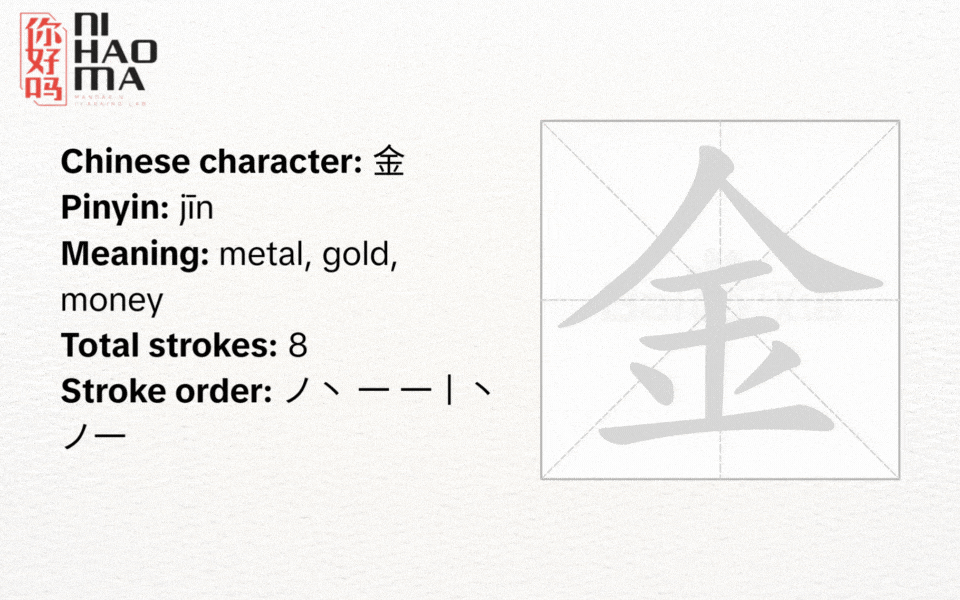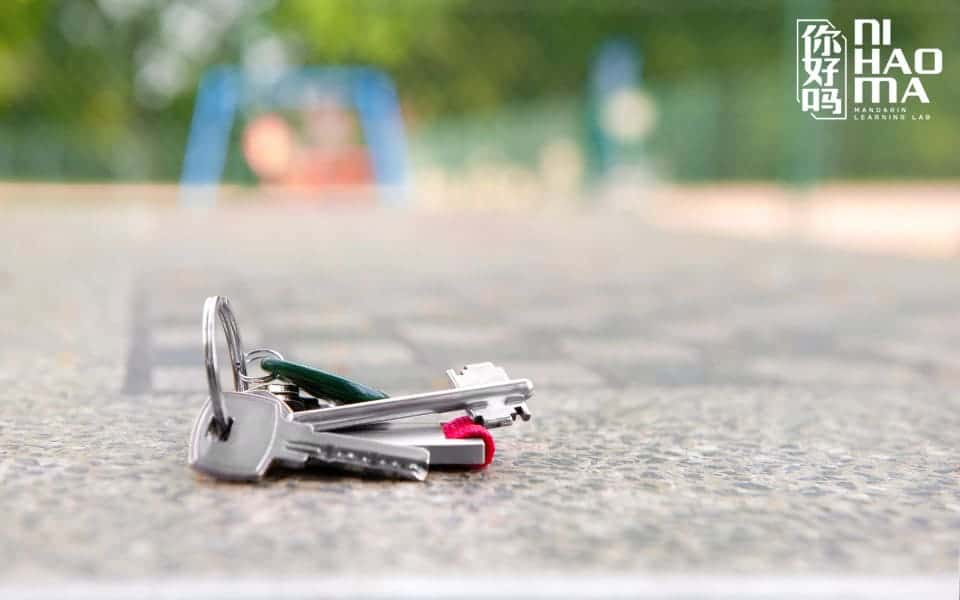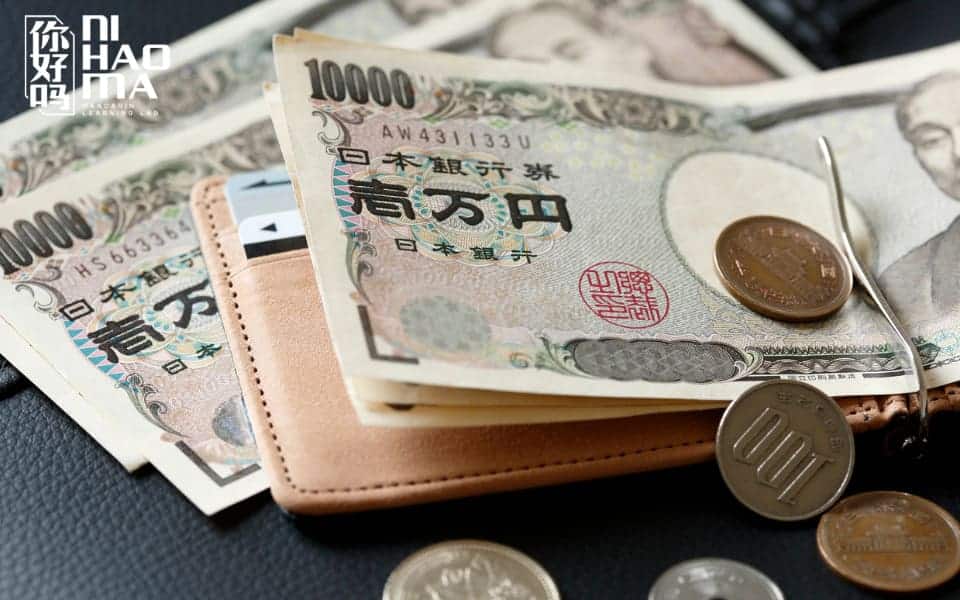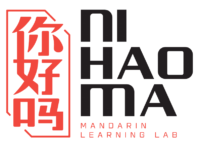The metal radical in Chinese is one of the most common radicals, appearing in many Chinese characters related to metals, money, or hard objects. Understanding the metal radical not only helps you quickly guess the meaning of a word but also makes it easier to remember the character’s structure. In this article, we’ll explore what the metal radical is, its meaning, correct stroke order, and the most common characters containing this radical.
What Is the Metal Radical in Chinese?
The metal radical in Chinese (金) is one of the 214 essential radicals in Chinese characters. Its original meaning refers to “metal,” “gold,” “metallic objects,” or substances that are hard, valuable, and durable.
When written independently, the metal radical appears as 金. However, when combined with other components in a character, it often takes the simplified form 钅. This compact variant keeps the character balanced while retaining the meaning related to metal, tools, machinery, or iron and steel objects.

Characters containing the metal radical Chinese usually convey meanings associated with metals, hard materials, tools, money, or actions involving metallic tools. Examples include: 铁 (tiě) – iron, 钟 (zhōng) – bell, 钱 (qián) – money, 钥 (yào) – key
- Radical: 金
- Pinyin: jīn
- Meaning: gold, money, metal
- Total Strokes: 8
- Stroke Order: ノ丶一 一丨丶ノ一
How to Write the Metal Radical in Chinese
The metal radical in Chinese (金) consists of 8 basic strokes, written in the following order:
| Stroke Order | Stroke Name | How to Write |
|---|---|---|
| 1 | Dot (丿) | Draw a short diagonal stroke from top to bottom, slightly curved to the left (top of the character). |
| 2 | Slash (乀) | Start from the same point as the first stroke and draw a long diagonal downwards, flicking to the right. |
| 3 | Horizontal (一) | Draw a long horizontal stroke in the middle, from left to right. |
| 4 | Horizontal (一) | Add another long horizontal stroke below the first one. |
| 5 | Vertical (丨) | Draw a straight vertical line passing through the two horizontal strokes above, going down. |
| 6 | Dot (丶) | Draw a small dot on the left side of the vertical stroke, below the second horizontal stroke, pointing down and slightly right. |
| 7 | Diagonal (丿) | Draw a small diagonal stroke from the right of the vertical line, mirroring the dot, pointing down and slightly left. |
| 8 | Horizontal (一) | Finish with a horizontal stroke at the bottom to complete the structure of the character. |
60 Chinese Vocabulary Containing the Metal Radical
If you want to improve your ability to recognize Chinese characters, learning vocabulary by radicals is an extremely effective method. This section lists 60 common Chinese words that contain the metal radical, helping you understand character structure and memorize vocabulary more easily.
| No. | Character | Pinyin | Meaning |
|---|---|---|---|
| 1 | 金 | jīn | gold, metal |
| 2 | 钢 | gāng | steel |
| 3 | 铁 | tiě | iron |
| 4 | 钥 | yào | key |
| 5 | 钱 | qián | money |
| 6 | 钟 | zhōng | bell |
| 7 | 银 | yín | silver |
| 8 | 铜 | tóng | copper |
| 9 | 钟 | zhōng | bell, clock |
| 10 | 铅 | qiān | lead |
| 11 | 铝 | lǚ | aluminum |
| 12 | 锅 | guō | pot, pan |
| 13 | 镜 | jìng | mirror |
| 14 | 钉 | dīng | nail |
| 15 | 铲 | chǎn | shovel |
| 16 | 钞 | chāo | paper money |
| 17 | 镑 | bàng | pound sterling |
| 18 | 错 | cuò | wrong, mistake |
| 19 | 锯 | jù | saw (tool) |
| 20 | 锐 | ruì | sharp, keen |
| 21 | 铠 | kǎi | armor |
| 22 | 镖 | biāo | dart, projectile |
| 23 | 镰 | lián | sickle |
| 24 | 钻 | zuàn | drill, bore |
| 25 | 钝 | dùn | dull (blade), slow-witted |
| 26 | 镇 | zhèn | suppress, guard; town |
| 27 | 钗 | chāi | hairpin |
| 28 | 钏 | chuàn | bracelet |
| 29 | 铩 | shā | injure, destroy |
| 30 | 铧 | huá | plowshare |

| No. | Character | Pinyin | Meaning |
|---|---|---|---|
| 31 | 针 | zhēn | needle |
| 32 | 钩 | gōu | hook |
| 33 | 锢 | gù | imprison, confine |
| 34 | 钹 | bó | cymbals |
| 35 | 铃 | líng | small bell |
| 36 | 链 | liàn | chain |
| 37 | 钩 | gōu | hook |
| 38 | 锤 | chuí | hammer |
| 39 | 锁 | suǒ | lock |
| 40 | 锋 | fēng | blade, sharp edge |
| 41 | 锡 | xī | tin |
| 42 | 鑫 | xīn | prosperity (three “gold” radicals) |
| 43 | 锄 | chú | hoe |
| 44 | 锁 | suǒ | lock |
| 45 | 镜 | jìng | mirror, lens |
| 46 | 鏖 | áo | fierce battle |
| 47 | 鉴 | jiàn | inspect, appraise |
| 48 | 铐 | kào | handcuffs |
| 49 | 钳 | qián | pliers |
| 50 | 钠 | nà | sodium |
| 51 | 钴 | gǔ | cobalt |
| 52 | 钾 | jiǎ | potassium |
| 53 | 钙 | gài | calcium |
| 54 | 锌 | xīn | zinc |
| 55 | 镍 | niè | nickel |
| 56 | 镉 | gé | cadmium |
| 57 | 钛 | tài | titanium |
| 58 | 锰 | měng | manganese |
| 59 | 铬 | gè | chromium |
| 60 | 镁 | měi | magnesium |
Dialogues Using Vocabulary with the Metal Radical in Chinese
Once you’ve mastered vocabulary containing the metal radical in Chinese, the next step to remember them effectively is to practice using these words in real-life conversation. In this section, Ni Hao Ma provides simple and easy-to-understand dialogues that include the most common Chinese words with the metal radical.
Dialogue 1
A: 你找到你的钥匙了吗?
Nǐ zhǎodào nǐ de yàoshi le ma?
Have you found your key yet?
B: 还没呢,我在包里找了半天。
Hái méi ne, wǒ zài bāo lǐ zhǎo le bàntiān.
Not yet. I searched my bag for a long time.
A: 会不会掉在公司了?
Huì bù huì diào zài gōngsī le?
Could it have been dropped at the office?
B: 有可能。那个门的锁又紧又旧。
Yǒu kěnéng. Nàge mén de suǒ yòu jǐn yòu jiù.
It’s possible. The door lock is very tight and old.
A: 现在几点了?
Xiànzài jǐ diǎn le?
What time is it now?
B: 六点半,我看了一下钟。
Liù diǎn bàn, wǒ kànle yíxià zhōng.
Six-thirty. I just checked the clock.
A: 那我们快点回去找吧,不然保安下班了。
Nà wǒmen kuàidiǎn huíqù zhǎo ba, bùrán bǎo’ān xiàbān le.
Then let’s hurry back to look for it, or the security guard will be off duty.

Dialogue 2
A: 你带钱了吗?
Nǐ dài qián le ma?
Did you bring money?
B: 我带了,不过好像不够。
Wǒ dàile, bùguò hǎoxiàng bú gòu.
I did, but it seems like it’s not enough.
A: 那我们去银行取一点吧。
Nà wǒmen qù yínháng qǔ yìdiǎn ba.
Let’s go to the bank and withdraw some more.
B: 好,可是我找不到我的钱包和钥匙。
Hǎo, kěshì wǒ zhǎo bùdào wǒ de qiánbāo hé yàoshi.
Okay, but I can’t find my wallet or my keys.
A: 你昨天不是放在外套口袋里了吗?
Nǐ zuótiān bú shì fàng zài wàitào kǒudài lǐ le ma?
Didn’t you put them in your jacket pocket yesterday?
B: 对!我想起来了。钱包里还有几张百元钞票。
Duì! Wǒ xiǎng qǐlái le. Qiánbāo lǐ hái yǒu jǐ zhāng bǎi yuán chāopiào.
Right! I remember now. There are still a few 100-yuan bills in my wallet.
A: 那就不用担心了,够用了。
Nà jiù bú yòng dānxīn le, gòu yòngle.
Then no need to worry. That should be enough.

Dialogue 3
A: 这个零件是铁的吗?看起来有点生锈。
Zhège língjiàn shì tiě de ma? Kàn qǐlái yǒudiǎn shēngxiù.
Is this part made of iron? It looks a bit rusty.
B: 对,是铁的,所以时间久了会生锈。
Duì, shì tiě de, suǒyǐ shíjiān jiǔle huì shēngxiù.
Yes, it’s iron. That’s why it rusts after a long time.
A: 要不要换成钢的?更结实也不容易坏。
Yàobùyào huàn chéng gāng de? Gèng jiēshi yě bù róngyì huài.
Should we replace it with a steel one? It’s stronger and less likely to break.
B: 我觉得可以。还有这条链子,你看,这个地方断了。
Wǒ juéde kěyǐ. Hái yǒu zhè tiáo liànzi, nǐ kàn, zhège dìfāng duànle.
That sounds good. And look at this chain — it’s broken here.
A: 我找一下工具箱,里面应该有备用的钢链和铁针。
Wǒ zhǎo yíxià gōngjùxiāng, lǐmiàn yīnggāi yǒu bèiyòng de gāngliàn hé tiězhēn.
Let me check the toolbox. There should be a spare steel chain and an iron pin.
B: 太好了,换好之后机器应该能正常工作。
Tàihǎo le, huàn hǎo zhīhòu jīqì yīnggāi néng zhèngcháng gōngzuò.
Great! Once replaced, the machine should work normally.
Conclusion
The metal radical in Chinese is one of the foundational radicals and often appears in characters related to metal, metallic tools, or valuable objects. To memorize it effectively, combine observing the radical’s shape, practicing regular writing, and learning through real-world examples. We hope Ni Hao Ma has provided helpful insights and don’t forget to check out our other articles on Chinese radicals!



